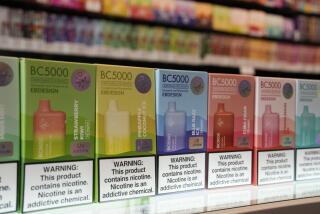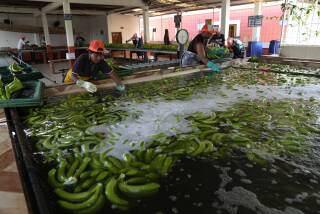Where Thereâs Smoke
SAN DIEGO â The sweetest forbidden fruit at the border nowadays is not white, powdery or from Colombia.
And it may not seem like the biggest threat to the Western world. But U.S. Customs Service officials are all fired up about a recent surge of the smuggling of Cuban cigars into San Diego.
In recent weeks, there have been back-to-back record seizures at the San Diego border, netting a cache of nearly 5,000 cigars with an estimated value of $283,500 on the black market, San Diego customs spokeswoman Bobbie Cassidy said.
The August seizures put San Diego squarely on the map of the Cuban contraband cigar trail, an exploding black market fueled by the yuppie cigar craze and a worldwide dictate that Cuba makes the champagne of puros.
âItâs big money,â said Rudy Camacho, top U.S. Customs administrator in San Diego. âItâs a new smuggling trend, and itâs indicative of the demand the American consumer has out there.â
Nationwide, seizures of Cuban cigars have increased sixfold in the past three years, to more than $1.1 million worth in fiscal 1996, according to the Customs Service.
Thatâs a leap from $318,401 in 1995 and a mere $142,014 in 1994, according to the service, which officials say reflects an increase in black market prices for the cigars as well as in seizures.
âItâs the forbidden fruit factor,â said Mike Sheehan, spokesman for customs in Miami, where Cuban cigars have become a status symbol for the terminally hip of South Beach.
âThe fact that itâs illegal and difficult to obtain makes it all the more desirable.â
San Diego got its first whiff of the problem Aug. 1, when customs inspectors at the San Ysidro border crossing found 2,025 cigars in the trunk of a 1972 Oldsmobile driven by Leonard Powell, 33, of Aliso Viejo, according to Assistant U.S. Atty. Bruce Smith, the prosecutor in the case. The cigars--high-end brands such as Montecristo, Romeo y Julieta, Cohiba Esplendidos--were valued at $121,500, a customs statement said.
On Aug. 23, customs officials found 2,700 cigars crammed in the trunk of the 1997 Chevrolet Cavalier driven by John Daniel Mejia, 26, of Montebello, Smith said. The Customs Service puts the value of that cache at $162,000.
Smith said both men were accused of failure to declare imported goods and knowingly possessing smuggled goods. They are to be arraigned Sept. 16.
If convicted, they could face up to five years in jail and fines of up to $10,000, he said.
In Miami, a hotbed of opposition to Cuban leader Fidel Castro, smugglers are sometimes accused of violating the Cuban trade embargo. That can bring stiffer penalties--up to 10 years in prison and $100,000 fines--but defendants often get probation and financial penalties, customs officials say.
At the heart of Cuban cigar fever is the trendiness of cigars.
In the past few years, cigars have become favored accessories for the likes of Demi Moore and Arnold Schwarzenegger. They have inspired the glossy specialty magazine Cigar Aficionado, whose cover has featured everyone from supermodel Claudia Schiffer to Castro, the man who made Cuban cigars emblematic.
Cuban hand-rolleds have a reputation as the best. The image endures in the face of critics who say the Communist countryâs capacity to maintain quality has been hurt by the economic crisis after the crumbling of the Soviet bloc.
Like Marlboro cigarettes, Cuban cigars have a mystique loaded with the machismo of a modern hemispheric maverick every bit as masculine as the cowboy--Fidel Castro.
The desirability of Cuban cigars is so undisputed that it is a leitmotif of that ultimate arbitrator of the yuppie zeitgeist, âSeinfeld.â Kramerâs love of Cubanos is a running gag.
Even a San Diego federal official admitted that he, too, sometimes sampled an occasional Havana cigar while in Baja California.
But the only people allowed to bring Cuban cigars into the United States are those returning directly from Cuba on a licensed trip, according to a U.S. Treasury statement. They can bring up to $100 worth, for personal use, not resale, it said.
The smuggling trend is a new one in San Diego, where Freon, endangered parrots, snakes--even a Siberian white tiger--have been found at the border. But thereâs nothing new about Cuban cigars--or trips to Cuba--in Baja California.
South of the border, aromatic counters of Cuban cigars have become common at tourist hotels, restaurants and stores. There is a weekly flight from Tijuana to Cuba, with a stopover to pick up passengers in Monterrey, that U.S. officials suspect brings some of the black market cigars.
Before the August seizures, customs officials found handfuls of Cuban cigars three or four times a week in car traffic across the worldâs busiest border, San Ysidro, spokesman said.
Customs officials say there is plenty of incentive for U.S. distributors to discreetly sell them, since high-quality Montecristos can fetch $100 each.
Customs officials say Los Angeles and San Francisco are major consumer cities, along with New York and Miami. In Southern California, customs officials believe that more than a few cigar shops secretly stock Cuban brands. Upscale restaurants and cigar clubs patronized by wealthy clientele are another suspected source. But no one is planning a public crackdown, officials say.
âThe public should not be concerned that weâre out there investigating every light-up of a Cuban cigar,â said Ed Logan, the special agent in charge of customs investigations along the California border.
At a time when international drug smuggling is a major concern, there seems to be a limit to how far law enforcement is willing to go to protect America from the Cuban cigar threat.
âThese are cigars, after all. Itâs not heroin,â said Mike Sheehan, one of the Customs Serviceâs nationwide experts on the issue.
More to Read
Sign up for Essential California
The most important California stories and recommendations in your inbox every morning.
You may occasionally receive promotional content from the Los Angeles Times.




![[20060326 (LA/A20) -- STATING THE CASE: Marchers organized by unions, religious organizations and immigrants rights groups carry signs and chant in downtown L.A. "People are really upset that all the work they do, everything that they give to this nation, is ignored," said Angelica Salas of the Coalition of Humane Immigrant Rights. -- PHOTOGRAPHER: Photographs by Gina Ferazzi The Los Angeles Times] *** [Ferazzi, Gina -- - 109170.ME.0325.rights.12.GMF- Gina Ferazzi/Los Angeles Times - Thousands of protesters march to city hall in downtown Los Angeles Saturday, March 25, 2006. They are protesting against House-passed HR 4437, an anti-immigration bill that opponents say will criminalize millions of immigrant families and anyone who comes into contact with them.]](https://ca-times.brightspotcdn.com/dims4/default/34f403d/2147483647/strip/true/crop/1983x1322+109+0/resize/840x560!/quality/75/?url=https%3A%2F%2Fcalifornia-times-brightspot.s3.amazonaws.com%2Fzbk%2Fdamlat_images%2FLA%2FLA_PHOTO_ARCHIVE%2FSDOCS%2854%29%2Fkx3lslnc.JPG)





